
Medieval fortification refers to medieval military methods that cover the development of fortification construction and use in Europe, roughly from the fall of the Western Roman Empire to the Renaissance. During this millennium, fortifications changed warfare, and in turn were modified to suit new tactics, weapons and siege techniques.

Toruń is a city on the Vistula River in north-central Poland and a UNESCO World Heritage Site. Its population was 196,935 as of December 2021. Previously, it was the capital of the Toruń Voivodeship (1975–1998) and the Pomeranian Voivodeship (1921–1945). Since 1999, Toruń has been a seat of the local government of the Kuyavian-Pomeranian Voivodeship and is one of its two capitals, together with Bydgoszcz. The cities and neighboring counties form the Bydgoszcz–Toruń twin city metropolitan area.

A castle is a type of fortified structure built during the Middle Ages predominantly by the nobility or royalty and by military orders. Scholars usually consider a castle to be the private fortified residence of a lord or noble. This is distinct from a mansion, palace and villa, whose main purpose was exclusively for pleasance and are not primarily fortresses but may be fortified. Use of the term has varied over time and, sometimes, has also been applied to structures such as hill forts and 19th- and 20th-century homes built to resemble castles. Over the Middle Ages, when genuine castles were built, they took on a great many forms with many different features, although some, such as curtain walls, arrowslits, and portcullises, were commonplace.

Lower Silesian Voivodeship in southwestern Poland, is one of the 16 voivodeships (provinces) into which Poland is divided. It covers an area of 19,946 square kilometres (7,701 sq mi), and as of 2019 has a total population of 2,899,986.

The Royal Castle in Warsaw is a state museum and a national historical monument, which formerly served as the official royal residence of several Polish monarchs. The personal offices of the king and the administrative offices of the royal court were located in the Castle from the 16th century until the final partition of Poland in 1795. Situated in the Castle Square, at the entrance to the Old Town, the Royal Castle holds a significant collection of Polish and European art.

Herstmonceux Castle is a brick-built castle, dating from the 15th century, near Herstmonceux, East Sussex, England. It is one of the oldest significant brick buildings still standing in England. The castle was renowned for being one of the first buildings to use that material in England, and was built using bricks taken from the local clay, by builders from Flanders. It dates from 1441. Construction began under the then-owner, Sir Roger Fiennes, and was continued after his death in 1449 by his son, Lord Dacre. The castle has been owned by Queen's University at Kingston, a Canadian university, since 1993.
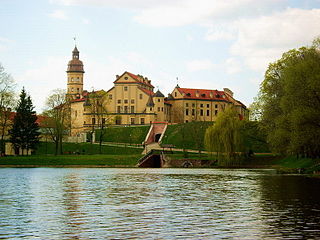
Nesvizh Castle or Nyasvizh Castle is a residential castle of the Radziwiłł family in Nyasvizh (Nesvizh), Belarus. It is 183 metres (600 ft) above sea level. Built in the 16th and 17th centuries, and maintained by the Radziwiłł family until 1939, the castle and the nearby Corpus Christi Church were instrumental in the development of Central European and Russian architecture. In 2005, the castle, church, and surrounding environment were inscribed on the UNESCO World Heritage List.

The Gothic architecture arrived in Poland in the first half of the 13th century with the arrival of the Dominican and Franciscan orders. The first elements of the new style are evident in the foundation of the Dominican Trinity church in Kraków (1226–1250), built by Bishop Iwo Odrowąż. Rebuilding of the Wrocław Cathedral, started in 1244, was another early manifestation of the Gothic style. The earliest building in Poland built entirely in the Gothic style is the chapel of St. Hedwig in Trzebnica (1268–1269), on the grounds of a Cistercian monastery.
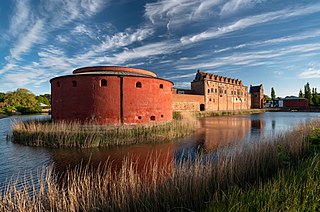
Malmö Castle is a medieval castle located on Slottsholmen in Malmö, Sweden. It was built between 1526 and 1539 and is thus the oldest preserved Renaissance castle in the Nordic region. Malmö Castle is part of The Malmö Museum. It is owned by the Swedish state and managed by the National Property Board. It also houses the Malmö Art Museum. The Commandant's House (Kommendanthuset) and the Castle Mill (Slottsmöllan) are also located near the castle.
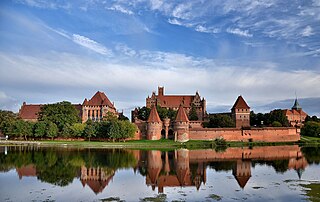
The Castle of the Teutonic Order in Malbork, commonly known as Malbork Castle, is a 13th-century castle complex located in the town of Malbork, Poland. It is the largest castle in the world measured by land area and a UNESCO World Heritage Site.

The Old Town is the name popularly given to the oldest part of Scotland's capital city of Edinburgh. The area has preserved much of its medieval street plan and many Reformation-era buildings. Together with the 18th/19th-century New Town, and West End, it forms part of a protected UNESCO World Heritage Site.

Stopnica is a town in Busko County, Świętokrzyskie Voivodeship, in south-central Poland. It is the seat of the gmina called Gmina Stopnica. It lies in Lesser Poland, approximately 17 kilometres (11 mi) east of Busko-Zdrój and 55 km (34 mi) south-east of the regional capital Kielce.

The Royal Castle in Poznań dates from 1249 and the reign of Przemysł I. Located in the Polish city of Poznań, it was largely destroyed during the Second World War but has since been partly rebuilt.

The architecture of Germany has a long, rich and diverse history. Every major European style from Roman to Postmodern is represented, including renowned examples of Carolingian, Romanesque, Gothic, Renaissance, Baroque, Classical, Modern and International Style architecture.
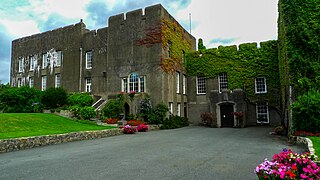
Fonmon Castle is a fortified medieval castle near the village of Fonmon in the Vale of Glamorgan and a Grade I listed building. The castle's gardens are designated Grade II on the Cadw/ICOMOS Register of Parks and Gardens of Special Historic Interest in Wales. With its origins rooted in the 12th century it is today seen as a great architectural rarity, as it is one of few buildings that was drastically remodelled in the 18th century, but not Gothicized. The castle is believed to have remained under the ownership of just two families throughout its history; from Norman times, it was owned by the St Johns, and from 1656, by the descendants of Colonel Philip Jones.
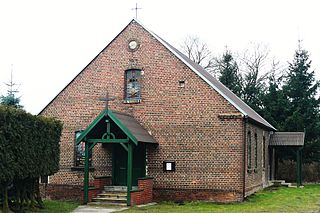
Stobnica is a village in the administrative district of Gmina Oborniki, within Oborniki County, Greater Poland Voivodeship, in west-central Poland. It lies approximately 16 kilometres (10 mi) north-west of Oborniki and 41 km (25 mi) north-west of the regional capital Poznań. Stobnica Castle is located near the village.

Lielvārde Castle is a castle in Lielvārde, a town in Ogre Municipality in the Vidzeme region of Latvia.The castle was built at the steep bank of Daugava River, overseeing this important medieval waterway, before 1248 by Albert of Buxthoeven, an archbishop of Riga. During the Livonian War, Lielvārde Castle was destroyed by Russian troops in 1579. Its ruins are conserved up to the level of the second floor.
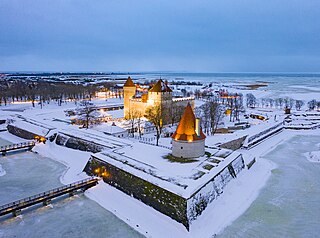
Kuressaare Castle, also Kuressaare Episcopal Castle, is a castle in Kuressaare on Saaremaa island, in western Estonia.

Gothic architecture is a style of architecture that flourished during the high and late medieval period. It evolved from Romanesque architecture and was succeeded by Renaissance architecture.





















